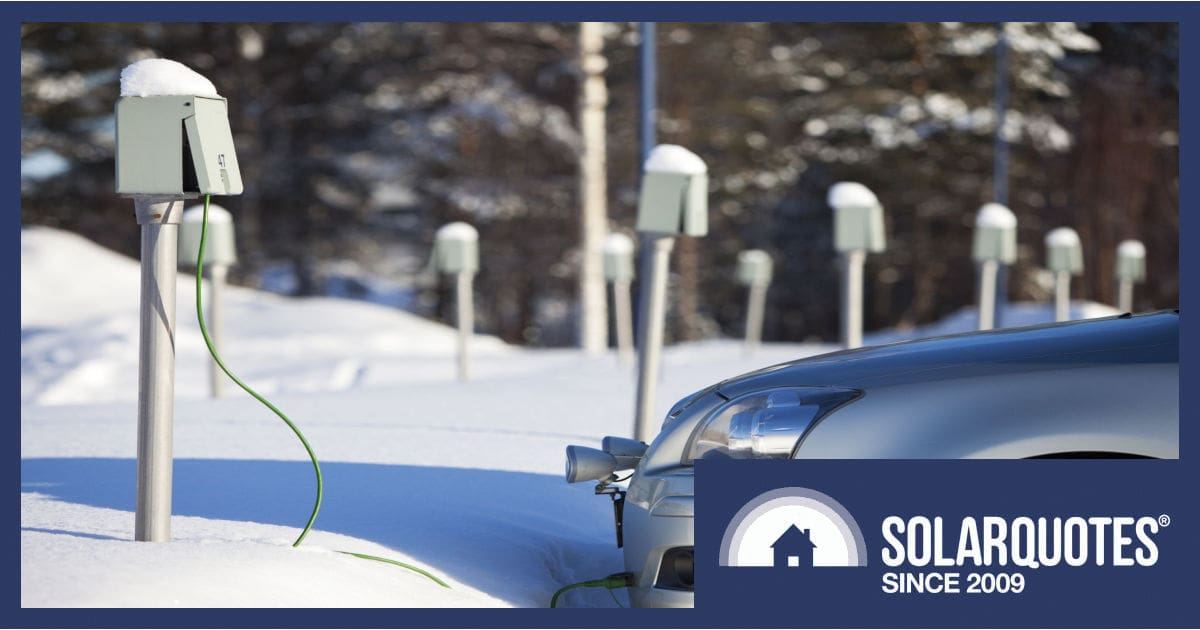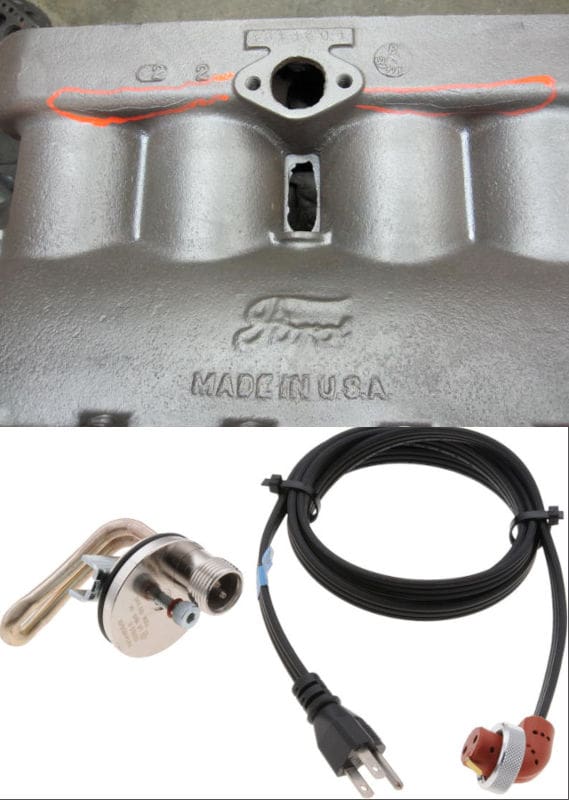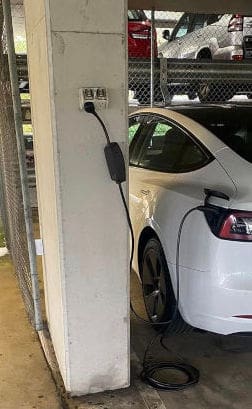 Naysayers claim electric vehicles simply won’t work at scale in a country like Australia. Yet there are countries with far more unfavourable conditions for EVs that are leading the way.
Naysayers claim electric vehicles simply won’t work at scale in a country like Australia. Yet there are countries with far more unfavourable conditions for EVs that are leading the way.
Plug In And Power On
If you talk to people in Canada & Norway, they have been plugging cars in since forever, because they simply must.
At low temperatures oil thickens & makes engines hard to start. When it’s well below zero the coolant in a combustion engine can freeze and literally tear the engine block apart.

Circled in red are cracks in an engine block caused by freezing. A small heating element prevents this irreparable damage.
To prevent catastrophic freeze damage, they run a heating element inside the engine, which is plugged into mains power provided by the businesses that want both patronage; and their staff to turn up.

Supermarkets arguably cater for car charging in Alaska already.
Frozen car parks are full of these pillars. While some are paid for by parking subscription, culturally they’re just an accepted norm and those who try to avoid this social obligation can find themselves without friends, customers or workers.

Thanks go to Randy for explaining in the comments section recently how providing power is part of the social contract in Canada.
It’s Not All Apple Pie
To give you an idea of the energy involved, the North Americans face a structural obstacle to EV rollouts because their basic power sockets are only rated to deliver 10Amps at 110Vac or 1.1kW at most.

Outrageously American, put a B&W filter on a stock image and it’s “fine art”.
Engine warmers use more power than an aquarium heater, but low mains voltage is also the reason the 110V peasants yanks like drip feed coffee; their kettles are too slow.
Using 230VAC, civilised countries can deliver twice as much power, so for Australia it’s pretty easy to get 2kW out of the wall with 10% headroom in the standard 10Amp power point rating, so we’re winning there.

Plus or minus 40 degrees yeah?
So What About Australia?
Fortunately in Australia we don’t have to grapple with catastrophic freeze damage or low mains voltage.
Our main challenge, as I outlined recently, is to make it easier for people to charge during the day, so we can make the most of all the excess solar energy being generated.
Multiple studies have found more than half of home charging is done using a standard power point, and its these we need to roll out more of in work carparks.

This must become a perfectly normal sight, but for safety’s sake, there should be a hook or shelf to prevent the EVSE “brick” hanging on the plug.
In my lived experience, the greatest thing about “granny chargers” is they’re reliably simple and simply reliable. There’s no app, no RFID card, no platform outages, no car software issues or support calls required. You just plug it in and it works.

Screwed collar pugs are a much better idea. They will accept extra heavy duty, high current capacity cable and they can’t be accidentally withdrawn.
To ensure EVs are charging during the day we should have power available to every car park, just like the cold countries already do, as well as Hong Kong.
Ideally we want both a standard outlet and the more robust type 2 EV charging socket for redundancy. Not everybody will have both, but having options is priceless.
Hit Your Boss Up
If you’re driving a company car, then it comes with a company fuel card doesn’t it? Company power points are a natural extension that can eliminate anxiety about range. Even without a company car, the utility of leaving work with a full tank of fuel means a great deal more to morale than any pizza party.
Make The Most Of Happy Hours
With her Plug in Hybrid EV taken for repairs, my wife was given a conventional loan car; and she was heartbroken. After years of partial EV motoring, never before had she repeatedly spent $90 at the petrol station.
With retail plans offering free happy hours around the middle of the day, daycharging becomes an economic imperative. In fact, for limited time windows a proper 3 phase charger makes even better sense to gather free electrons while they’re available.
For more on the benefits on EV charging during the day to the grid, read Anthony’s deep-dive explainer.

 RSS - Posts
RSS - Posts



You can bet your bottom dollar if your employer provided you with electricity to charge your EV, Jim Chalmers would be looking for his FBT cut. And that wont be based on free grid power during solar excesses, it will be based on the dearest power sold in the area (if the way they charge FBT for spacing spaces is anything to go by).
But the biggest issue is the myth that Australians needs lots of range because 1% of the population regularly drives more than 200km a day… Even when i had 3 hours of commuting to get to work, most of that was spent parked, the distance was only about 110k.
Granny chargers is all that is needed for a parking lot where a car will sit for 9 hours a day. If that cant give you enough juice to get home and then back to work the next day in 9 hours, then well, shock horror, you will have to plug it in at home!
Andrew, like petrol in an ICE car, or the car space you are provided at work, it would be a fringe benefit from your employer. But it is tax advantaged because it is significantly cheaper than paying for electricity out of your post tax income – just like the company car or novated lease car. I do not see what the problem is with that.
Why would electricity be rated for FBT as some rate other than what the benefit provider pays for it? Maybe they have a large solar array on the roof or a very good electricity plan and it could be free in certain hours. The finance area would probably have to work out an average cost for typical hours parked.
As for the parking space variable cost, a space in the Sydney CBD, for example, costs vastly more than one in the surrounds of outer suburban Sydney.
We have power available in many places already that could be used for topups. This would reduce the need for larger charges at home (for those with the capacity or help those without it.
I’m sorry that isn’t Jim Chalmer’s decision, FBT on benefits provided as part of one’s employment is a tax law principle that has existed at least since I worked at the ATO in the 90’s and likely earlier. If an employer provides a benefit for staff working at their employ, it is usually FBT-able unless it is specifically excluded by law or ruling.
Yes, but the rules aren’t as strict as you might think. eg. Christmas parties are FBT free as long as they cost less than $300 per person. Which really isn’t that hard to get under. There are plenty of exemptions, including EV cars (or has that changed?).
Our problem is that our staff generally have to park on the street, otherwise there aren’t enough car parks for customers. Our customers only stay 10 minutes, so they wouldn’t be interested.
There are 2 considerations: in order for an employer to charge for power, he must be registered as an energy reseller. It is possible to register as a zero-profit reseller, where you are recompensed for costs, so it might be possible to meter the charge, then charge for grid inputs, or a reasonable amount for PV generated power. Zero cost grid imports could not be charged. The other possibility is to hand the management of the chargers to a registered EV management co, such as ChargeFox. The employer then gets a profit share, but there is a handling cost to the consumer. I doubt either of these methods would be a Fringe benefit unless paid with pre-tax earnings.
I registered for the Energy resellers licence years ago when I had flats where I included reasonable power usage in the rental agreement. (The rules changed recently tho)
I don’t have an EV so please go easy …
My question is to those experienced in matters EV.
When do tradies charge their utilities?
During cheap solar intense hours the Ute is randomly parked at building sites, where extension leads are more often stolen than utilised by the owner.
OR do they discharge their own home battery each evening?
Yes, and that means each supply to each employee will have to be measured and reported.
It will be interesting to see how it is “assigned a cost” because when they built a public car park near work, the assigned FBT cost for us parking each day because we were within 1km of a commercial car park, was the same as what that car park charged. Not what it cost the employer to provide the car park.
Hi Anthony
I could not agree more with everything you say but granny chargers still need their own circuit which has an initial cost and that can vary dramatically.
We have had a 24kWh LEAF for 5+ years and almost exclusively charged with solar/granny charger during the day but on the occasion 4 years ago we tried to use that charger away from home it ended with tripping circuit breakers everywhere I tried it, lastly even at a BP service station that was being helpful.
Finally I found the nearby pub had new motel units with outdoor power points on their own circuit so I stayed the night, hot shower, cold beer and a hot meal, what’s not to like except effectively over $150 to charge the car !
I am pretty sure there are more fast chargers on the route now but the LEAF is a 2014 so will need a new battery but still fine for local travel up to 45 kms each way.
In fairness we have a diesel vehicle as well but it is lucky to 5000kms pa.
At the start of the end of the horse and buggy era, pioneer motorists pulled over to chemists to buy a tin of “spirits” to fuel their fire breathing vehicles. It took a while for better infrastructure to scale, and hand-pouring flammables to end.
At the end of primitive fire breathing vehicles, we again need to hasten the infrastructure transition, to make it all flow. I’m guessing late adopters will just say “That was easy.”, as it usually is in hindsight. It’s living through the renovations which grates like plaster dust in your coffee.
In the absence of a million shelves for granny chargers to fall off, perhaps manufacture the cable with more length before the brick, so it can lie on the ground, as mine does. Ample plastic => strong enough to drive over.
Last century, our Mech Eng lecturer was a retired Indian Army colonel. Up in the Himalayas, his men lit fires under the diesel powered tanks half an hour before starting their engines. (No power points up there, I guess. 😉
I feel an equal or greater “main challenge”, besides making it easier for people to charge during the day in town, is our sparseness and rural infrastructure.
Urban is easy in comparison.
The vast highways, distances, isolation, and importantly the volume of vehicle traversing those routes.
Coupled with very few charging stations, then very limited number of chargers at key points, with very limited grid availability to cope with vehicle numbers travelling, it makes charging on highway drives less practical as more and more EVs hit the roads.
It’s no good having people arrive to charge at a 10 outlet station, find with a full house and a queue waiting, that each charger is hobbled to share the grid available, making wait time to do an 80% charge untenable.
It’s also not practical or conducive to have any number of highway charging stations hooked up to diesel generators.
For now, EVs seem ideal for urban use, most homes where highway trips are common, still need a PHEV or ICE options.
Les, I feel there are things you might not be aware of. For a start, there are diesel powered EV chargers in WA. Some even run off Vege-oil (recycled from the roadhouse). There was a study undertaken by AEVA, WA that worked out it is more efficient to Diesel charge an EV than actually drive a diesel powered car. The reasoning was that diesel generators are quite efficient compared to diesel powered vehicles.
I have owned EVs for 13 years. Initially, our old Imiev only travelled within 50-60 Km from home. 5 years ago we bought a Kona EV. We have undertaken many trips (150000 Km in 5 years) using commercial chargers. We have found that travelling out of tourist times makes it easier to charge, but have had occasions we have ´stacked´. The other issue is the failure of Tritium chargers: we have even lost some locations such as the Sports Hub at Pimpana (GC council withdrew all their charging locations unfortunately).
When travelling I always carry a charging cable & a granny charger.
While you make some good points, I think that is a bit too much of a generalisation to say “most homes where highway trips are common, still need a PHEV or ICE options”.
I will buy an EV soon. The EVs I am looking at will have a range of 550kms+ and range is increasing with each new model of most vehicles. I live near Port Macquarie and the typical long distance trips I do are to Newcastle, Sydney, Canberra and around Brisbane. I could nearly reach those cities on a full charge done at home. I would only need to do a smaller topup when I stop for a break. All of these routes I have checked and are well served with available chargers anyway.
One 1600kms route I use annually is currently very poor for charging but I would probably be towing on that trip so would use my diesel 4WD.
Most of our population lives along the eastern seabord or near it which is already well served with chargers. And it will get better. Much better indeed than our crappy mobile phone coverage!
There does seem to be a mindset that we as (South) Australians are stuck with fossil fuels because of sparse population. It’s self perpetuating if charge points aren’t installed if there’s no demand for them. As it is, in my forays be they to Robe, Roxby Downs, Renmark, Port Lincoln, Ceduna and wherever around Adelaide I’ve never had to wait for a charge point to become available. Broken Hill and Alice Springs are beyond my 50kWh unless I were to overnight in accommodation and turtle charge.
The rain follows the plough.
Some good points people, and yes I’m in SA, and my son with his 6 year old tesla X, now on 300k km, battery about 80% health / SOC capacity.
He commutes regularly back from Melbourne to home, and initially he could do that easily with one stop and charge, and never had to wait at then then limited superchargers.
Even now, with more along the route, not so much per station, but stations themselves, with his SOC capacity he now makes 3 stops, all be they 15 min – 20 min, still adds an hour to his trip.
I want a small snd hand EV for surburbs, not prepared to buy a new one, depreciation is maddening . . . eg his $170k x is now lucky to be sold for $45-$50k.
He’s looking long range Y now, yes, the battery tech is head and shoulders above that of the x 6 years ago, so maybe not so bad this time.
I’m seeing Pickles EV auctions with 50k Ys going and battery SOC reports of 95%, so not too bad.
. . . cont.
Anyway, the point is that if the EV market continues to expand fast (which does seem to have stalled a bit now), we will see what I mentioned in the original post, huge queues, wait times, especially on popular routes, arriving / leaving from popular destinations, and the charger infrastructure in Euro / US etc is FAR FAR more advanced that in Australia, notably taking our expanses into consideration.
A good topic, one of the situations I saw online was a Scandinavian country leaving a ski resort town after a weekend, the queues were unbelievable, literally blocks long, many were running out of battery in the wait.
Another in the US, a 40 odd bay tesla station full and dozens in line.
The doco maker had to abandon the charge, return to his accommodation, and depart next day.
I guess in the last parts of the 19th century, petrol stations were under the same issues.
I’m all for EVs, but until things are developed, I’ll be happy with 2nd hand, urban runaround, charged free here at home.
It’s a great idea, but I’m not holding my breath.
It’s one of those “public good” customs that seem natural if you have them, because they’ve always been there. But if you don’t, you’ll never get them, because people have entrenched views and you’ll be howled down.
I asked AI for the Aussie equivalent and it gave me…
…public BBQs in parks. You know, the free or coin-op hotplate monoliths. Apparently unique to Aus and NZ. Dunno why, they’re great for a picnic.
If any other country decided that was a good idea, they’d never get up. Cost to build. Cost to operate (we’re just giving away free energy?) Food safety. Think of the children, what if they burn themselves??? If you want a BBQ, bring your own. etc. etc. etc.
So yes. A good idea, add it to the pile…
We moved from PHEV to full EV (Tesla M3) six years ago and have never looked back. It’s still absolutely fabulous, and does soo much more than when brand new thanks to constant updates. Ignoring tyres, it has cost NOTHING to maintain. (Of course if I live another forty years, I might need new brake pads 🙂 We still have a diesel SUV in the garage but it quite literally goes MONTHS without getting used. It’s “out of the ark” in comparison to our Tesla and the ONLY reason we keep it is for heavy towing (a 3 tonne caravan). It’s slow, noisy, expensive to run, expensive to maintain and much much more. My wife now refuses to drive it and I certainly don’t enjoy driving it.
If NOT for heavy towing, we would certainly have another electric vehicle (likely another Tesla) in the garage. (There are some real bargains now if you’re looking for second hand.)
Some people: “BUT you’ll need a new battery.” Rubbish!
Agree, lots of pickles auction EVs going too from time to time.
Yesterday, 2 Ys both with just under 50k went up, both passed in, not a bid, the first for $35k, the 2nd for $33k.
Both batteries were checked and certificated at 95% ish.
A bid of just $500 more would have got one, both needed slight cosmetic tidying up.
Loads of council and govco EV auctions happening monthly, comes and goes.
We certainly are behind the game when it comes to charging.
Yesterday I watched a video blog by a German trucker driving a Mercedes eActros semi from Germany to Istanbul. At the plant where he had to collect his load, there was a charging facility for electric trucks which was rated at 300kw. He had driven some distance to the plant so he topped up to full while his trailer was loaded.
He proceeded to drive towards Turkey, about 2,500kms each way. Using a couple of apps and his installed Google nav he often stopped at specialised truck charging points coinciding with his rest breaks. These had great facilities and were often located in typical freeway services so had restaurants etc. The truck carried 20 tons and had a range of well over 600kms. Most of these chargers could deliver 300kw and some up to 450kw. And worked.
While we couldn’t cover all Australia in the foreseeable future with similar facilities, why not the major highways from Brisbane to Adelaide as a start?
Interesting, but I think you need to think even longer term.
Most places I know, car parking is in short supply. To put it frankly, car parking spaces are expensive for businesses to build, mainly because they take away from the space you can earn income.
I have never complained about it to anyone, because I see the solution in 10 years time is simply that after dropping you off to your destination, your self driving car will drive itself to somewhere parking is free, or at least cheap. Putting charging stations in there makes sense.
Derek, I’m having a little bit of trouble resolving the conflict between the two paragraphs – if parking is too expensive to be affordable, then when EVs self-drive, won’t they just drive back home to charge on (near) zero cost renewable energy, rather than incur the high cost of the cited expensive parking plus the exaggerated cost of commercial charging?
With a coded automatic garage door, and wireless in-floor charger, Kit can be ready for the evening pickup with only a level 2 charge rate, even in outer suburbia, I figure.
It’d take a very high RUC to make them stay in the CBD, then.
Minor correction: single phase basic power points in the USA and Canada are rated at 120 volts and 15 amps. Mexico is 127 volts and 15 amps.
BMW is already looking toward the post-EV era: https://www.news.com.au/technology/motoring/on-the-road/bmw-plans-for-life-after-evs/news-story/e8cd0366db7547edafc392f9c458ac02
Les in Adelaide correctly identifies the big issue, what about when you leave the capitals? Yes this piece includes a comment by Randy Wester about the “social contract in Canada” but is that all Canada, or just the main cities?
Remember, Canada’s big cities are mostly along the US border, loosely akin to Australia’s east coast. And while Canada’s population is larger (41,651,653 v 28,063,000) it’s the reverse for city share of population 38.7% in the top 5 cities v 61%!
-Toronto 14.9% of Canada’s population v Sydney’s 19.4!
-Montreal 10.3% v Melbourne’s 18.6%
-Vancouver 6.3% v Brisbane’s 9.6%
-Ottawa–Gatineau’s 3.6% v Perth’s 8.2%
-Calgary’s 3.6% v Adelaide’s 5.2%
Supersized cities mean Australia’s regions are doubly less dense than Canada’s, which means less support for EVs!
Personally, I feel H2 will never happen. Who would own a BMW anyway? (TIC).
My reasoning is that H2 is less efficient, leaks from containers (so higher losses), & requires fuel transport. That could not compete with fuel that is carried on wires, & effectively costs the same no matter where you are on the network. There will need to be Govt subsidies for rural charger establishment, but I feel that is a small price to pay. Tesla has already built PV powered chargers, so it is possible to have off-grid charging (again requiring govt subsidies).
All I think that is required is the rural; chargers to be built. & PLEASE! make the EV charging spots bigger (1.5 width, sized as a disability park) & make the charger hardware accessible from a wheelchair (Pedestal on road level, reasonably flat site). This makes charging easier for everyone, including the few with real disabilities, then the next group with partial disabilities such as walking sticks.
Precisely Doug,
EV chargers need to be accessible with trailers too.
John Alba: – “BMW is already looking toward the post-EV era:…”
Comparing hydrogen fuel cell vs battery-electric road vehicles:
1. Comparing hydrogen and battery electric trucks
https://www.transportenvironment.org/articles/comparing-hydrogen-and-battery-electric-trucks
2. Battery electric cars are at least three times more efficient than hydrogen fuel cell cars due to energy losses.
https://x.com/transenv/status/899976235794788352
3. Why battery-powered vehicles stack up better than hydrogen
https://theconversation.com/why-battery-powered-vehicles-stack-up-better-than-hydrogen-106844
I think BMW is backing the wrong horse.
Meanwhile, CATL’s Naxtra sodium-ion battery is a new generation of battery technology, offering significant advantages over traditional lithium-ion batteries, with potentially lower costs ($10/kWh), longer lifespan (10k+ cycles), superior cold-weather performance, improved safety & with a certified energy density of 175 Wh/kg.
Hi Eric.
I think our perspective is just different. I live rural residential and almost never go near the city centre. So home is a 40 minute drive (50km away), and free street parking is next to work.
However if I want charging, then I don’t want the car to drive all the way home (wear and tear), I just want it to pop around to a “charging carpark”, where it will plug itself in and charge. Perhaps there aren’t enough people like me to make this an option. We will see.
If however you live 5 minutes from work, then your proposal make 100% sense.
Cheers
Derek
Why do some people refer to turtle chargers as “granny” chargers? It makes no sense to me. It’s an insult to grandfather/grandmother stereotypes, implying some lack of ability. Balance charging is important for healthy battery longevity, underrated by focus on blisteringly fast megachargers.
Slow destination charging during a workday with wholesale electricity near-nigh free during the daytime is perfect for South Australians, and anywhere else with access to sun.
A quick search suggests they’re called such either because they’re slow, or because they’re simple. Either way it’s not polite.
Not so much an insult to grandfathers as granny refers exclusively to female grandparents. Apparently it can also refer to a midwife in parts of the US, a revolving cap on a chimney pot that keeps out rain (architecture), or an irritatingly fussy person. Not sure any of those are better though!
I am in the age group. I feel it is just a colloquialism, & not meant to be condescending. They are slow tho!
Seems you forgot to mention the government subsidiaries for evs paid for by government subsidiaries of gas and oil
Close to the poles winter day is gloomy 4-6 hours. Those electric cars are not being charged from solar for sure. Norway and Canada winters are mild compared to Siberia and there have never been any electric sockets to keep the engines warm.
Hi Gate,
My impression of Siberia is that they simply don’t switch them off in winter. Overlanders get out and jack the vehicle up, rest it on stands and let the vehicle idle overnight. It’s left in gear with the wheels spinning so the driveline oils don’t congeal, while the heater keeps the occupants warm.
Not really a thing in Australia, or anywhere else you’d want to live.
The only problem with EVs is misinformation from the Luddite tin foil hat wearers and conspiracy theorists of who we have an over abundance of in Australia.
If you look at the future in positive innovative way with an eye to the mistakes of the past there’s no problems we can’t overcome ( improvise adapt and overcome) not divide destroy and polarise as do certain people in society eg politicians who will do or say whatever to get a vote backed up by their media and mining oil and gas mates and will be the main cause of any energy shortage or price blowout here in Australia.
If rural/regional towns have any sense they’ll install ev chargers which will encourage ev drivers to visit those areas and while they are charging they will most likely end up spending a dollar and help to keep those communities alive as the local country store with a petrol bowser out the front did in the past.
Well, there is one other problem with EVs, Malcolm. The price.
I bought my current ICE car about 7-8 years ago for $7,500 (a 2010 Volvo wagon). I have driven it all over NSW and done numerous interstate trips. Used it to tow boats and a trailer full of furniture. Carried tons of building materials on the roof rack. It’s been very versatile and remarkably reliable.
I’m not a Luddite and I would happily switch to an EV if I could get all that for under $10,000. I’m sure prices will come down and there will be more second hand ones available, but for people on a tight budget it’s just not currently economically viable.